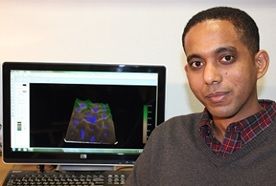Quantification of Spatio-temporal Distribution of Surface Ponding and the Related Dynamic Processes

Noah Habtezion is a graduate student (Ph.D./M.S.) in the department of Civil and Environmental Engineering at North Dakota State University. He received his B.S. degree in Civil Engineering from the University of Asmara, Eritrea. He is currently working on his M.S. thesis and his current research is focused on microtopography and the related hydrologic processes (hydromicrotopography) modeling.
Email: noah.habtezion@my.ndsu.edu
Fellow: Noah Lebassi Habtezion
Advisors: Dr. Xuefeng Chu, Associate Professor, Department of Civil & Environmental Engineering, North Dakota State University
Degree Progress: M.S./Ph.D. in Civil Engineering
Quantification of Spatio-temporal Distribution of Surface Ponding and the Related Dynamic Processes
Surface depressions and the relevant surface ponding dynamics have unique hydrologic features and play important roles in overland flow generation, the occurrence of floods and droughts, the hydrodynamics and ecological functions of the associated wetlands, and the sustainability of the related agricultural systems in North Dakota. Thus, the knowledge of temporal and spatial distributions of depressions and the quantitative methods of surface ponding dynamics would improve the understanding of such problems and help identify effective strategies and solutions.
Project Objectives:
This proposed study will focus on the important water resources topics with broad practical implications in North Dakota associated with surface ponding, depression filling-spilling-merging processes, and discontinuous overland flow. The specific objectives of this study are:
- to quantify surface depressions and surface ponding across temporal and spatial scales using the puddle-to-puddle (P2P) modeling system developed in our group, and
- to examine surface ponding dynamics and overland flow generation under the influence of a number of factors, including surface microtopography, rainfall features, soil properties, and initial soil moisture contents.
Significance:
Specifically, the P2P model will provide detailed simulation outputs for all the scenarios, including puddles and their microtopographic characteristics, spatial and temporal variations in surface ponding, P2P filling-spilling-merging-splitting dynamics, outlet hydrographs, infiltration and unsaturated flow, soil moisture distributions, and hydrologic connectivity.
This study is expected to improve our understanding of the critical role of surface ponding and overland flow dynamics. Modeling of surface ponding has broad practical implications and application potentials across different fields. Particularly, such a detailed study on surface ponding and overland flow generation would potentially help identify better solutions for flood prediction and control. The outcome of this study may also be used for water resources planning and management and other multidisciplinary areas. This study will be a fundamental part of my M.S. thesis research and I believe that this research opportunity also will be invaluable to my future career.
Conference/Presentation:
Habtezion, N. and X. Chu. 2013. Segmentation of land surface image using object-based method. North Dakota/South Dakota Engineering Research Summit, NDSU, UND, and SDSU, April 23, 2013, Brookings, SD (Presentation).
Chu, X., J. Yang, and N. Habtezion. 2012. Dynamic puddle delineation and threshold-driven hydrotopographic processes. AGU Fall Meeting, December 3-7, 2012, San Francisco, CA. (Presentation)
Chu, X. and N. Habtezion. 2013. Applications of the Green-Ampt Method across Scales. Proceedings of the 2014 ASCE World Environmental and Water Resources Congress, American Society of Civil Engineers, Accepted (Proceeding Paper).

Dr. Xuefeng (Michael) Chu
Director, ND Water Resources Research Institute & Civil and Environmental Engineering
Office: CIE 201K
Phone: (701) 231-9758
Email: xuefeng.chu@ndsu.edu


